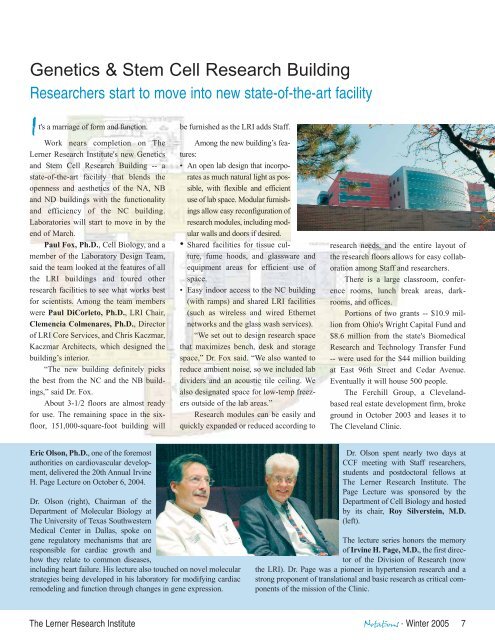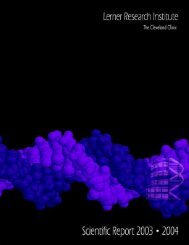The Lerner Research Institute Notations - Cleveland Clinic Lerner ...
The Lerner Research Institute Notations - Cleveland Clinic Lerner ...
The Lerner Research Institute Notations - Cleveland Clinic Lerner ...
- No tags were found...
Create successful ePaper yourself
Turn your PDF publications into a flip-book with our unique Google optimized e-Paper software.
Genetics & Stem Cell <strong>Research</strong> Building<strong>Research</strong>ers start to move into new state-of-the-art facilityIt's a marriage of form and function.Work nears completion on <strong>The</strong><strong>Lerner</strong> <strong>Research</strong> <strong>Institute</strong>'s new Geneticsand Stem Cell <strong>Research</strong> Building -- astate-of-the-art facility that blends theopenness and aesthetics of the NA, NBand ND buildings with the functionalityand efficiency of the NC building.Laboratories will start to move in by theend of March.Paul Fox, Ph.D., Cell Biology, and amember of the Laboratory Design Team,said the team looked at the features of allthe LRI buildings and toured otherresearch facilities to see what works bestfor scientists. Among the team memberswere Paul DiCorleto, Ph.D., LRI Chair,Clemencia Colmenares, Ph.D., Directorof LRI Core Services, and Chris Kaczmar,Kaczmar Architects, which designed thebuilding’s interior.“<strong>The</strong> new building definitely picksthe best from the NC and the NB buildings,”said Dr. Fox.About 3-1/2 floors are almost readyfor use. <strong>The</strong> remaining space in the sixfloor,151,000-square-foot building willbe furnished as the LRI adds Staff.Among the new building’s features:• An open lab design that incorporatesas much natural light as possible,with flexible and efficientuse of lab space. Modular furnishingsallow easy reconfiguration ofresearch modules, including modularwalls and doors if desired.• Shared facilities for tissue culture,fume hoods, and glassware andequipment areas for efficient use ofspace.• Easy indoor access to the NC building(with ramps) and shared LRI facilities(such as wireless and wired Ethernetnetworks and the glass wash services).“We set out to design research spacethat maximizes bench, desk and storagespace,” Dr. Fox said. “We also wanted toreduce ambient noise, so we included labdividers and an acoustic tile ceiling. Wealso designated space for low-temp freezersoutside of the lab areas.”<strong>Research</strong> modules can be easily andquickly expanded or reduced according toresearch needs, and the entire layout ofthe research floors allows for easy collaborationamong Staff and researchers.<strong>The</strong>re is a large classroom, conferencerooms, lunch break areas, darkrooms,and offices.Portions of two grants -- $10.9 millionfrom Ohio's Wright Capital Fund and$8.6 million from the state's Biomedical<strong>Research</strong> and Technology Transfer Fund-- were used for the $44 million buildingat East 96th Street and Cedar Avenue.Eventually it will house 500 people.<strong>The</strong> Ferchill Group, a <strong>Cleveland</strong>basedreal estate development firm, brokeground in October 2003 and leases it to<strong>The</strong> <strong>Cleveland</strong> <strong>Clinic</strong>.Eric Olson, Ph.D., one of the foremostauthorities on cardiovascular development,delivered the 20th Annual IrvineH. Page Lecture on October 6, 2004.Dr. Olson (right), Chairman of theDepartment of Molecular Biology at<strong>The</strong> University of Texas SouthwesternMedical Center in Dallas, spoke ongene regulatory mechanisms that areresponsible for cardiac growth andhow they relate to common diseases,including heart failure. His lecture also touched on novel molecularstrategies being developed in his laboratory for modifying cardiacremodeling and function through changes in gene expression.Dr. Olson spent nearly two days atCCF meeting with Staff researchers,students and postdoctoral fellows at<strong>The</strong> <strong>Lerner</strong> <strong>Research</strong> <strong>Institute</strong>. <strong>The</strong>Page Lecture was sponsored by theDepartment of Cell Biology and hostedby its chair, Roy Silverstein, M.D.(left).<strong>The</strong> lecture series honors the memoryof Irvine H. Page, M.D., the first directorof the Division of <strong>Research</strong> (nowthe LRI). Dr. Page was a pioneer in hypertension research and astrong proponent of translational and basic research as critical componentsof the mission of the <strong>Clinic</strong>.<strong>The</strong> <strong>Lerner</strong> <strong>Research</strong> <strong>Institute</strong> <strong>Notations</strong> · Winter 2005 7
















